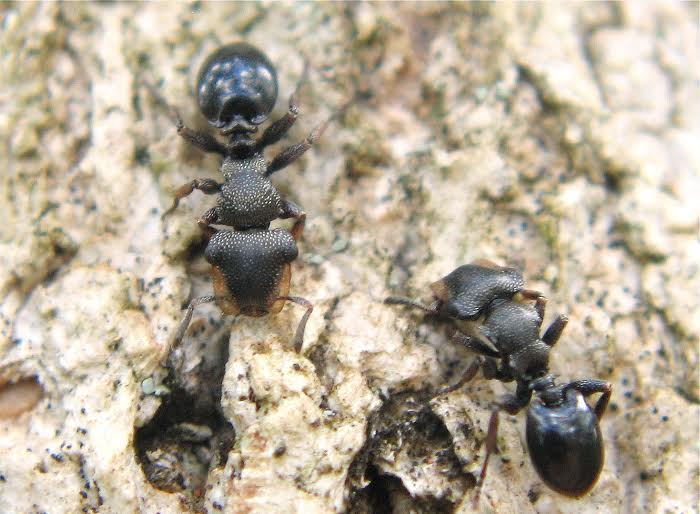Hundreds of thousands of belligerent, jet-black ants envelop the low-lying tree branches in Brazil’s woodland savanna. Intruders who dare cross the workers’ paths face jolts from their venomous stingers.
Yet, in the midst of these defend-to-the-death ants, a group of impostors—a new ant species discovered by a George Washington University professor—go undetected. The stealthy, parasitic ants infiltrate the host’s marching lines while in disguise. They steal their food. And they escape.
The new ant species is called Cephalotes specularis, or the “mirror turtle ant.”
 |
| Scott Powell observes ants from the top of a cerrado tree in the Brazilian savanna. |
“This is an entirely new form of social parasitism in ants. The mimicking, eavesdropping and nesting behavior of the mirror turtle ant has never been seen before,” said Scott Powell, an assistant professor of biology in the Columbian College of Arts and Sciences.
Dr. Powell first discovered the mirror turtle ant while conducting fieldwork in Brazil. He had climbed up into a tree to observe the thousands of hyper-aggressive host ants on their search for food, when he noticed that one thing “wasn’t quite like the others.”
Here’s what Dr. Powell witnessed from his tree perch:
The mirror turtle ant nests just inches away from the well-guarded enemy enclave. The host ants, Crematogaster ampla, travel by the thousands on a busy highway system, dropping chemical messages to their fellow workers along the way. During rush hour, the mirror turtle ants, also colored black, dive out of their nest and rapidly merge into the high-speed traffic.
Once inside the host’s foraging network, the mirror turtle ants disguise themselves among the enemy workers by “mirroring” their unique body movements. The impostors go largely unnoticed as they quickly weave through traffic lanes and dodge the host ants. This mimicking behavior—along with their unprecedented ability to “eavesdrop” on the host’s trail pheromones—allows the parasitic ants to successfully locate and exploit the host’s food resources.
“I did a true double take,” Dr. Powell said. “I saw these ants that looked almost identical to the others, but they were behaving a bit differently, dodging away quickly when they got too close to another ant. They were in amongst them, but trying to keep their distance.”
With help from collaborators in Brazil, Dr. Powell determined that he had indeed stumbled upon a type of turtle ant that had never previously been identified. Turtle ants, Dr. Powell’s primary research focus, are a diverse group of arboreal ants, with 118 extant species currently recognized. The mirror turtle ant’s name holds a dual meaning: the parasite both “mirrors” the behavior of its host and also has a reflective body.
After identifying this new ant species, Dr. Powell and his team of researchers conducted experiments to better characterize the different components of the parasite-host interaction.
They watched as the mirror turtle ants raised their backsides in the air, imitating the distinctive posture of the C. ampla. They also observed the parasitic ants’ keen capacity to “eavesdrop” on the host ants’ pheromone-based foraging trails. The mirror turtle ants are so skilled at this, in fact, that they are better at following the chemical trails of the host ant than those of their own workers. The researchers’ studies also revealed that mirror turtle ants were embedded within a whopping 89 percent of host territories.
Their findings were published in the October edition of The American Naturalist.

The parasitic mirror turtle ant (right) mimics the raised body posture of the host (left) in order to trick the host into thinking the parasite is one of its own. (Photo credit: Scott Powell).
But what makes this parasite-host interaction particularly unique is that the host and the mirror turtle ant live and care for their own young in entirely separate nests. This is a type of interaction known as xenobiosis. By contrast, other species of parasitic ants live inside their host’s nest and become entirely dependent on the host, eventually losing their free-living biology.
Because of the mirror turtle ants’ rare form of nesting ecology, as well as the fact that this seems to be a relatively recent parasite-host interaction, Dr. Powell and his team have the opportunity to better understand how and why social parasitism evolves.
Eventually the host ant will begin detecting the parasite, but the parasite will find new ways to trick the host. Over time, the host-parasite relationship could completely transform. It’s what Dr. Powell calls “an evolutionary arms race.”
“Beyond the fascinating biology of this new ant, we appear to have a rare window into the early stages of the evolution of social parasitism, before the parasite has lost much of its free-living biology,” Dr. Powell said. “This promises to help us better understand the general pressures that tip a species toward a parasitic lifestyle.”
Watch as a mirror turtle ant dodges the host worker ants at a liquid food source:


